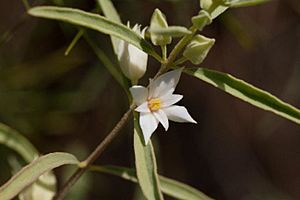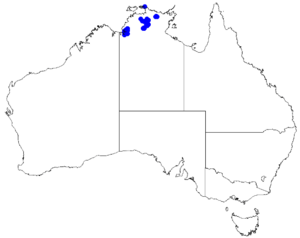Boronia grandisepala facts for kids
Quick facts for kids Boronia grandisepala |
|
|---|---|
 |
|
| Boronia grandisepala in the Nitmiluk National Park | |
| Scientific classification | |
 |
|
| Occurrence data from Australasian Virtual Herbarium |
Boronia grandisepala is a special plant that belongs to the citrus family, called Rutaceae. It is found only in the northern parts of the Northern Territory in Australia. This plant is a shrub that stands upright and has oval-shaped leaves. Its flowers can be white, pink, or a deep red (burgundy) color, and they always have four petals.
What Does It Look Like?
Boronia grandisepala is an upright shrub that can grow up to about 1.5 meters (5 feet) tall and wide. Its branches and leaves are covered with tiny, star-shaped hairs. The leaves are usually oval or slightly spear-shaped. They are about 7 to 55 millimeters (0.3 to 2.2 inches) long and 1.5 to 14 millimeters (0.06 to 0.55 inches) wide. Each leaf has a small stalk, called a petiole, that connects it to the stem.
The flowers usually grow one by one where a leaf meets the stem. Each flower sits on a tiny stalk called a pedicel. The four sepals, which are like small leaves that protect the flower bud, are bigger than the petals. They can be white, pink, or burgundy. These sepals grow even larger as the fruit starts to form. The four colorful petals are about 4 to 6 millimeters (0.16 to 0.24 inches) long. You can usually see this plant flowering from December to June.
How It Got Its Name
The plant Boronia grandisepala was first officially described in 1859. A scientist named Ferdinand von Mueller wrote about it in his book Fragmenta phytographiae Australiae.
The second part of its scientific name, grandisepala, tells us something about the plant. It comes from two Latin words: grandis, which means "large," and sepalum, which means "sepal." So, grandisepala means "large-sepaled Boronia," referring to its big sepals.
In 1997, another scientist, Marco Duretto, found there were two slightly different types of this plant. These are called subspecies. They are now recognized by the Australian Plant Census:
- Boronia grandisepala subsp. grandisepala: This type has gray leaves that are up to 45 millimeters (1.8 inches) long. It also has more hairs on its leaves.
- Boronia grandisepala subsp. acanthopida: This type has leaves that are not gray and can be up to 55 millimeters (2.2 inches) long. It has fewer hairs. The name acanthopida comes from Deaf Adder Falls, a place where this subspecies is found. A death adder is a type of snake from the genus Acanthophis.
Where It Lives
The subspecies grandisepala grows in open woodlands and areas with low, shrubby plants (heath). You can find it from near Jim Jim Falls all the way to the Nitmiluk National Park.
The subspecies acanthophida prefers to grow in sandstone heath and woodland areas. It is found between Jim Jim Falls and Deaf Adder Falls, which is about 40 kilometers (25 miles) north.
Looking After This Plant
The Northern Territory Government has a special law called the Parks and Wildlife Conservation Act. Under this law, Boronia grandisepala is considered to be of "least concern." This means that there are plenty of these plants, and they are not currently at risk of disappearing.

